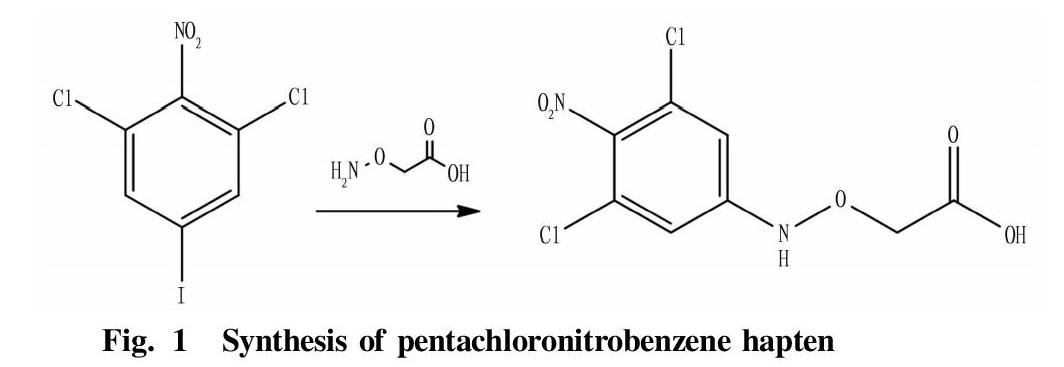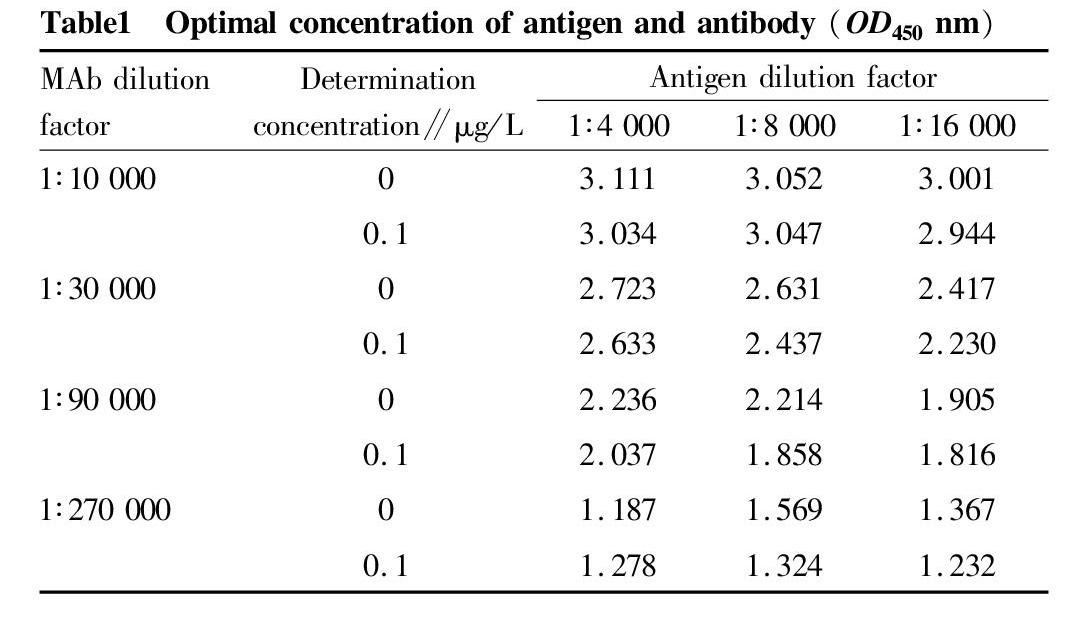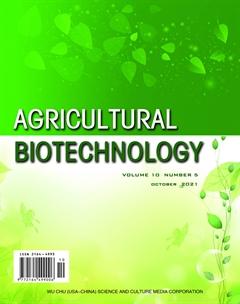Study on the Production of Pentachloronitrobenzene
Yuhua MA Kuo ZHANG Jianxiong ZHANG Fangfang JIA Fangyang HE Yanan CUI Mingyang LI Yuping WAN



Monoclonal Antibody and Its ELISA Kit for Rapid Detection
Abstract [Objectives] This study was conducted to develop an enzyme-linked immunoassay kit that can detect the residual amount of pentachloronitrobenzene in Penaeus vannamei.
[Methods]This study was conducted to develop an enzyme-linked immunoassay kit that can detect the residual amount of pentachloronitrobenzene in P. vannamei.
[Results] The standard curve range of the kit was 0-8.1 μg/L; the detection limit for P. vannamei was 0.912 μg/kg; the recovery was 80.6%-103.5%; and the relative standard deviation range within batches was 5.3%-10.1%, and the relative standard deviation range between batches was 6.7%-8.1%. The specificity of the pentachloronitrobenzene monoclonal antibody was relatively good, and the cross-reaction rates with pentachlorophenol, hexachlorobenzene, tetrachlorophthalide, and chlorothalonil were low, all of which did not exceed 30%. The ELISA kit could be stored at 4 ℃ for 12 months, showing good stability.
[Conclusions]The detection kit has low cost, short time and small deviation, and is an ideal preliminary screening method.
Key words Pentachloronitrobenzene; Monoclonal antibody; Enzyme linked immunosorbent assay kit
Received: April 29, 2021 Accepted: July 1, 2021
Supported by Key R&D Program of Hebei Province: Special Project on Key Common Technologies for High-quality Agricultural Development (20327505D).
Yuhua MA (1984-), female, P. R. China, engineer, devoted to research about food safety rapid detection technology.
*Corresponding author. E-mail: zhen0803zhen@sina.com.
Pentachloronitrobenzene is an organochlorine microbicide with stable chemical properties, not easy to be degraded. It can exist for a long time in soil, water and other environments. Therefore, its safety issues have attracted widespread attention. Countries such as Europe and the United States have adopted measures to ban or restrict the use of pentachloronitrobenzene[1]. In order to ensure an increase in grain production and a bumper harvest while protecting the safety of the ecological environment, China has not yet banned the use of pentachloronitrobenzene, but stipulated the use of the drug. GB 2763-2019 National food safety standard—Maximum residue limits for pesticides in food[2] stipulates the maximum residue limits of pentachloronitrobenzene in various foods: 0.01-0.10 mg/kg for grains; 0.01-0.50 mg/kg for oils and fats; 0.05-0.20 mg/kg for vegetables; 0.02 mg/kg for watermelons; 0.1 mg/kg for poultry meat and poultry viscera.
Gas chromatography-mass spectrometry[3-10], gas chromatography[11-17], liquid chromatography[18], high performance liquid chromatography[19] and other instrument methods are common methods for detecting pentachloronitrobenzene. The test data of the instruments are accurate, and they are confirmatory methods, but they cannot test samples in large quantities in basic laboratories. The reason is that the costs of the instruments, the detection cost of a single sample and the labor cost are all high, and basic laboratories, especially smaller enterprises, cannot afford it. Therefore, a low-cost and short-time rapid detection method is needed as a preliminary screening method. In this study, pentachloronitrobenzene hapten was prepared, its monoclonal antibody was then obtained by an immunological experiment, and finally, an enzyme-linked immunoassay kit capable of detecting the residual amount of pentachloronitrobenzene in Penaeus vannamei was developed. With the advantages of the above-mentioned quick inspection methods, it is an ideal preliminary screening method.
Materials and Methods
Materials and instruments
Pentachloronitrobenzene standard product (purity≥95%), pentachlorophenol standard product (purity ≥95%), hexachlorobenzene standard product (purity ≥95%), tetrachlorophthalide standard product (purity ≥95%), chlorothalonil standard product (purity ≥95%): Beijing Reference Material Research Center; Bovine serum albumin (BSA) (analytically pure), ovalbumin (OVA) (analytically pure): Sigma, USA; 1,3-dichloro-5-iodo-2-nitrobenzene (analytically pure), anhydrous ethanol (analytically pure), carboxymethylhydroxylamine (analytically pure), sodium methoxide (analytically pure), petroleum ether (analytically pure), ethyl acetate (analytically pure), dimethyl sulfoxide (analytically pure), ammonium sulfide (analytical grade), carbodiimide (analytical grade): Beijing Baixin Reagent Company; Litopenaeus vannamei: supermarket.
MK3 microplate reader (with a maximum measuring range of 4.0): Thermo Labsystems (Shanghai) Co., Ltd..
Preparation of antigen
Preparation of hapten
First, 3.16 g of 1.3-dichloro-5-iodo-2-nitrobenzene was added with 100 ml of anhydrous ethanol to dissolve it, and the obtained liquid was added with 15 ml of aqueous solution containing 2.4 g of carboxymethylhydroxylamine dropwise, and then with 1.08 g of sodium methoxide. After heating and refluxing for 4 h, the reaction was stopped. Rotary evaporation was performed to remove ethanol. The residue was added with 100 ml of water, and the pH was regulated to 6 with 1 mol/L hydrochloric acid. The obtained liquid was extracted for three times with ethyl acetate, 100 ml each time. The organic phases were combined, evaporated to dryness, and loaded onto a silica gel column. Elution separation was performed with petroleum ether/ethyl acetate (v/v, 1/1), obtaining 2.3 g of carboxy-o-dichloronitrobenzene hapten product with a yield of 82.4%.
In this study, 1,3-dichloro-5-iodo-2-nitrobenzene was used as a raw material to synthesize the unique structural fragments of pentachloronitrobenzene with carboxymethylhydroxylamine under the catalysis by sodium methoxide through the nucleophilic substitution reaction with the iodine on the benzene ring. The product was immunized with coupling protein to prepare specific antibodies against pentachloronitrobenzene.
Preparation of immunogen
First, 11 mg of carboxy-o-dichloronitrobenzene was dissolved and clarified by adding 1 ml of DMSO. The obtained liquid was then added with 6.7 mg of NHS and 9.7 mg of EDC, and after fully dissolution and mixing, the reaction was progressed at room temperature for 2 h, obtaining a hapten activation liquid A. Next, 50 mg of bovine serum albumin (BSA) was dissolved in 6 ml of 0.1 M CB 9.5 to it, giving liquid B. Liquid A was added to liquid B dropwise, and the reaction was performed at room temperature for 4 h and then stopped. The reaction system was purified for 3 d by 0.02 M PBS dialysis. After centrifugation and aliquoting, the carboxy-o-dichloronitrobenzene-BSA conjugate was obtained, which was the immunogen.
Preparation of coating source
First, 9 mg of carboxy-o-dichloronitrobenzene was dissolved and clarified by adding 1 ml of DMSO. The obtained liquid was added with 5.4 mg of NHS and 8.2 mg of EDC, and after fully dissolution and mixing, the reaction was performed at room temperature for 2 h, obtaining hapten activation solution A. Next, 50 mg of ovalbumin (OVA) was dissolved in 6 ml of 0.1M CB 9.5, giving liquid B. Liquid A was added to liquid B dropwise, and the reaction was performed at room temperature for 4 h and then stopped. The reaction system was purified for 3 d by 0.02 M PBS dialysis. After centrifugation and aliquoting, the carboxy-o-dichloronitrobenzene-OVA conjugate was obtained, which was the coating source.
Preparation of enzyme-labeled anti-antibody
The immunogen obtained under "Preparation of immunogen" was used to immunize Balb/c mice. The mice produced antiserum. Their spleen cells were fused with SP2/0 myeloma cells, and a hybridoma cell line was obtained through cloning. After purification, a pentachloronitrobenzene monoclonal antibody[20] was obtained, which was used to immunize pathogen-free goats, obtaining a goat anti-mouse anti-antibody[21], which was coupled with horse radish peroxidase (HRP)[22], finally obtaining the enzyme-labeled anti-antibody.
Optimization of the concentrations of antigen coating and monoclonal antibody, and preparation of the ELISA plate
The percent absorbance of the standard pentachloronitrobenzene at the measurement wavelength of 450 nm was calculated at concentrations of 0 and 0.1 μg/L according to the following formula, and the antigen dilution times were 1∶4 000, 1∶8 000 and 1∶16 000, respectively; and the dilution factors of monoclonal antibody were 1∶10 000, 1∶30 000, 1∶90 000 and 1∶270 000, respectively; and the dilution factor of enzyme-labeled anti-antibody liquid was 1∶1 000.
Percent absorbance (%) = (Average absorbance value of standard or sample solution/Average absorbance value of 0 μg/L standard solution)×100%.
The antigen coating liquid was coated to a microtiter plate. After incubating and washing the plate, 0.02 mol/L PBS buffer (containing 0.05% bovine serum albumin by weight) was added, and the ELISA plate used for detection could be obtained after incubation[23].
Calculation of the content of pentachloronitrobenzene in L. vannamei samples
According to the relationship between the concentration of pentachloronitrobenzene standard substance (abscissa) and the percent absorbance of the standard substance (ordinate), a Logit-log linear regression model was made. After detecting the sample, the OD450 nm of the sample was substituted into the model, and the corresponding sample concentration could be calculated.
Detection performance
Detection of limit of detection
Twenty blank samples of L. vannamei were tested, and the limit of detection (LOD) was the average concentration value of the blank samples plus 3 times the standard deviation[24].
Precision and accuracy
Pentachloronitrobenzene was added to the L. vannamei sample to obtain spiked samples with concentrations of 1, 2 and 4 μg/kg, respectively. The recovery was measured with the kits, and the accuracy of the kits was judged according to the recovery. In addition, three batches of microtiter plates were used to detect four parallels of each spiked sample, and the relative standard deviation (RSD%) was calculated to determine the precision of the kits.
Determination stability
The kit stored for different time (1, 2, 3, 4, 5, 6, 7, 8, 9, 10, 11, 12 months) was used for testing L. vannamei samples, and the stability of the kit was judged based on whether the test results were accurate.
Determination of antibody specificity
The structures of pentachlorophenol, hexachlorobenzene, tetrachlorophthalide, chlorothalonil and pentachloronitrobenzene are similar. The IC50 values of the drugs were determined, and the cross-reaction rates of the kits for pentachlorophenol, hexachlorobenzene, tetrachlorophthalide, and chlorothalonil were calculated according to the following formula:
Cross-reaction rate (%)=The concentration of pentachloronitrobenzene causing 50% inhibitionConcentration of pentachloronitrobenzene analog causing 50% inhibition×100%
Results and Analysis
Preferred antigen coating concentration and monoclonal antibody concentration
The OD450 nm values of pentachloronitrobenzene standards with concentrations of 0 and 0.1 μg/L were measured, as shown in Table 1.
When the inhibition rate of OD450 nm (0.1 μg/L)/OD450 nm (0 μg/L) was 70%-85%, the maximum dilution factors of the antigen and monoclonal antibody were used as the optimal dilution factors of antigen and monoclonal antibody[25]. When the antigen dilution factor was 8 000 and the optimal monoclonal antibody dilution factor was 90 000, OD450 nm (0.1 μg/L) was 1.858, OD450 nm (0 μg/L) was 2.214, and the inhibition rate of OD450 nm (0.1 μg/L)/OD450 nm (0 μg/L) was 83.9%. It could be seen that the optimal dilution factor of the antigen was 8 000, and the optimal dilution factor of the monoclonal antibody was 90 000.
Logit-log linear regression model
The results showed that the linear equation was y=-1.547x-0.019 1, R2=0.997.
Calculation of the detection limit
In this study, the detection limit of P. vannamei samples was 0.912 μg/kg, as shown in Table 3.
Yuhua MA et al. Study on the Production of Pentachloronitrobenzene Monoclonal Antibody and Its ELISA Kit for Rapid Detection
Precision and accuracy
P. vannamei samples added with different concentrations of pentachloronitrobenzene were determined, and the recovery ranged from 80.6% to 103.5%. It could be seen that when the added concentration was 1, 2 and 4 μg/kg, the relative standard deviation range within batches was 5.3%-10.1%; and the relative standard deviation range between batches was 6.7%-8.1%. The results are shown in Table 4.
Determination stability
The kit was stored at 4 ℃. The maximum absorbance value (0 μg/L) of the kit from January to December ranged from 1.61 to 1.92, and the recovery ranged from 81.0% to 104.9%. There was no abnormality in the three indexes of the stability test, and the kits within the test time range could be used normally.
Determination of antibody specificity
The pentachloronitrobenzene antibody cross-reacted with pentachlorophenol, hexachlorobenzene, tetrachlorophthalide, and chlorothalonil. The cross-reaction rates were 100%, 2.5%, 6.8%, 29.1%, 16.4%, respectively, indicating that the cross-reaction rate between pentachloronitrobenzene antibody and pentachloronitrobenzene was higher (100%), while the cross-reaction rates with pentachlorophenol, hexachlorobenzene, tetrachlorophthalide, and chlorothalonil were low, all of which did not exceed 30%.
Conclusions and Discussion
The literatures are all about the detection of samples of vegetables, fruits, soil, etc., and no rapid detection methods for the detection of pentachloronitrobenzene in P. vannamei have been researched.
In this study, we prepared an anti-pentachloronitrobenzene monoclonal antibody, developed a corresponding ELISA kit, and optimized the antigen coating concentration and monoclonal antibody concentration. The standard curve range of the kit was 0-8.1 μg/L; the detection limit for P. vannamei was 0.912 μg/kg; the recovery was 80.6%-103.5%; and the relative standard deviation range within batches was 5.3%-10.1%, and the relative standard deviation range between batches was 6.7%-8.1%. The specificity of the pentachloronitrobenzene monoclonal antibody was relatively good, and the cross-reaction rates with pentachlorophenol, hexachlorobenzene, tetrachlorophthalide, and chlorothalonil were low, all of which did not exceed 30%. The ELISA kit could be stored at 4 ℃ for 12 months, and the main indexes were within normal ranges, showing good stability[26].
References
[1] DING RY, GUO CY, DU HX, et al. The use and risk analysis of pentachloronitrobenzene in vegetables in Shandong Province[J]. Quality And Safety of Agro-Products, 2018(4): 46-48. (in Chinese)
[2] XU W, LIU TJ, HUANG Q. Application and optimization of QuEChERS in determination of pentachloronitrobenzene and chlorothalonil residues in vegetables[J]. Journal of Guizhou Medical University, 2019, 44(7): 810-813, 820. (in Chinese)
[3] HOU JR, GAN PS, LI XJ, et al. Determination of pentachloronitrobenzene and chlorothalonil residues in vegetables by automated solid phase extractor with GC-MS/MS method [J]. Journal of Medical Pest Control, 2020, 36(9): 917-920. (in Chinese)
[4] CAO ZB, ZHANG YY, LIU XJ, et al. Determination of pentachloronitrobenzene and chlorothalonil residues in vegetables by solid phase extraction-gas chromatography triple quadrupole mass spectrometry[J]. Journal of Food Safety & Quality, 2020, 11(12): 4132-4136. (in Chinese)
[5] SONG LJ, LIAO XM, LI TG, et al. Determination of pentachloronitrobenzene and chlorothalonil residues in vegetables by solid phase extraction-gas chromatography triple quadrupole mass spectrometry[J]. Journal of Food Safety & Quality, 2020, 30(7): 786-788. (in Chinese)
[6] WANG Z. WANG YD, YIN MR, et al. Determination of quintozene and chlorothalonil residues in apple by gas chromatography/mass spectrometry with automated solid phase extraction[J]. Food Science and Technology, 2019, 44(1): 345-349. (in Chinese)
[7] WANG JX, HU ZB, ZHANG XZ, et al. Evaluation of uncertainty in determination of quintozene in pseudo-ginseng by gas chromatography-tandem mass spectrometry[J]. Journal of Food Safety & Quality, 2018, 9(9): 2164-2168. (in Chinese)
[8] ZHAO L, SHI Z, ZHANG RY, et al. Optimization of pretreatment method for determination of nitrobenzene residues in fruits and vegetables by gas chromatography-mass spectrometry [J]. Journal of Food Safety & Quality, 2017, 8(9): 3619-3622. (in Chinese)
[9] ZHAO L, DONG YY, RONG GQ, et al. Determination of quintozene and chlorothalonil residues in fruit by gas chromatography/mass spectrometry[J]. Journal of Anhui Agricultural Sciences, 2017, 45(9): 94-95. (in Chinese)
[10] JIN YS, LIU QC, CHEN T. Gas purge microsyringe extraction for GC/MS determination of pentachloronitrobenzene, pentachloroaniline and pentachlorothioanisole from the ginseng complex sample[J]. Journal of Yanbian University: Natural Science, 2011, 37(2): 140-143. (in Chinese)
[11] LUO Y. Determination of pythiril, fenvalerate, fenpropathrin and pentachloronitrobenzene residues in soil by solid phase extraction GC-ECD method[J]. Chemical Engineer, 2020, 34(8): 28-30. (in Chinese)
[12] LIN ZP, LIN C, WU LT, et al. Health food and Chinese herbal medicine by capillary column-gas chromatography method for the determination of BHC, DDT and analysis of the residues of PCNB[J]. Shandong Chemical Industry, 2017, 46(17): 84-86, 88. (in Chinese)
[13] ZHOU HM. Simultaneous determination of BHC, DDT and pentachloronitrobenzene in tea by gas chromatography[J]. Enterprise Standardization, 2017(1): 76-77. (in Chinese)
[14] ZHU HF, HU MH, HU GX. Determination of pentachloronitrobenzene in fruits by QuEChERS coupled with gas chromatography[J]. Modern Preventive Medicine, 2016, 43(19): 3584-3585, 3614. (in Chinese)
[15] SONG JY, ZHOU JY, CHEN JD, et al. Determination of quintozene residues in health food and Chinese herbal drugs by capillary gas chromatography[J]. Chinese Journal of Pharmaceutical Analysis, 2011, 20(2): 55-57. (in Chinese)
[16] ZHU XH, LI T, XU CG, et al. Determination of quintozine in gastrodia by hollow fiber-based liquid phase microextraction coupled with gas chromatography[J]. Chinese Journal of Pharmaceutical Analysis, 2010, 30(12): 2283-2286. (in Chinese)
[17] LI J, DONG FS, LIU XG, et al. Simultaneous determination of pentachloronitrobenzene residue and its metabolites pentachloroaniline and pentachlorothioanisole in ginseng based on matrix solid phase dispersion and gas chromatography[J]. Journal of Agro-Environment Science, 2009, 28(1): 216-220. (in Chinese)
[18] XIN RZ, WANG SM, DING M. Rapid determination of pentachloronitrobenzene residue in fruit-vegetable juice by high-performance liquid chromatography[J]. The Beverage Industry, 2011, 14(7): 31-35. (in Chinese)
[19] JIN YF, OUYANG LQ, WU FZ. Determination of quintozene residues in vegetables by high performance liquid chromatography[J]. Chinese Journal of Health Laboratory Technology, 2011, 21(2): 361-362. (in Chinese)
[20] LIU XJ, FENG CW, FENG J, et al. Study on the folic acid enzyme linked immunosorbent assay kit for rapid detection[J]. Science and Technology of Food Industry, 2013, 34(23): 303-310. (in Chinese)
[21] YANG LG, HU SC, WEI PH, et al. Enzyme-linked immunoassay[M]. Jiangsu: Nanjing University Press, 1998. (in Chinese)
[22] GUO CX, GUO XQ. Introduction of a simple, fast and efficient sodium periodate method for horse radish peroxidase-labeled antibody[J]. Immunological Journal, 1983(33): 97-100. (in Chinese)
[23] ZHENG BQ, LUO XQ, FENG CW, et al. An enzyme linked immunosorbent assay kit for rapid detection [J]. China Brewing, 2014, 33(2): 130-133. (in Chinese)
[24] FENG RF. Analysis sensitivity (detection limit)[J]. Shanghai Journal of Medical Laboratory Sciences, 2002, 17(3): 133-136. (in Chinese)
[25] DONG LX, FENG CW, FENG J, et al. Preparation of monoclonal antibodies against ofloxacin and preliminary development of its enzyme linked immunosorbent assay kit for rapid detection[J]. Chinese Animal Husbandry and Veterinary Medicine, 2014, 41(8): 90-94. (in Chinese)
[26] TANG WG. Preparation and application of medical laboratory diagnostic reagents[M]. Shanghai: Shanghai Scientific and Technological Literature Press, 1996. (in Chinese)
- 农业生物技术(英文版)的其它文章
- Effects of Pruning Methods on the Growth and Development of New Shoots and Fruit Yield and Quality of Walnut
- Selection of Grape Varieties Suitable for Double Cropping a Year in Northern Greenhouse
- Effects of Uniconazole on Photosynthetic Characteristics of Dahlia pinnata Cav. under Drought Stress
- Community Structure and Value Evaluation of Local Brassicaceae Potherbs in Shiyan City
- Home Planting Techniques of Green and Healthy Rape Sprouts
- Research Progress of Polygonatum Germplasm Resources in China

